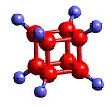Wednesday, 6 May 2009
The power of cow dung
A NEWSLETTER FOR YOUR REFERENCE
Siba Mohanty First Published : 08 Nov 2008 01:59:00 AM ISTLast Updated : 11 Nov 2008 01:17:53 AM IST
A silent revolution is taking place in Orissa to reduce greenhouse gas emissions. While policymakers and energy strategists are harping on the need to tap wind, solar, biomass and hydel power to meet the energy needs of India, this eastern state is going back to the good old days when cows provided most of the fuel. Cow power, if one may so describe it, is a demonstration of how traditional technology can be used to generate carbon credits and bring in the euros for end users living in far-flung villages.
Very recently, Orissa entered into a tie-up with a German bank to sell carbon reductions generated through biogas plants in the state. The pact between Orissa Renewable Development Agency (OREDA), the state government’s nodal agency for renewable and non-conventional energy sources, and KfW Bankengruppe will mean that around 11,000 biogas plants stand to gain from certified emission reductions (CER) — carbon credits issued under the clean development mechanism (CDM) — they trade with this foreign bank. Each plant would make about Rs 6,000 worth of CER a year.
This may sound modest when nuclear energy is the flavour of the season across the country. Nonetheless, it makes sense considering that the Union government is struggling to meet the energy needs of rural India. After all, electricity tariffs are slated to rise in the years to come, making power more of a mirage for the average user. Demand for power is so huge that even the 123 Agreement won’t mean much in the long run. Even by government estimates, civil nuclear energy will only produce about 20,000 MW by 2020, which is about 10 per cent of the total power generated in India. Renewable energy is, probably, a more convincing option.
For instance, biogas would not only meet the household energy requirements and enhance livelihood options for villagers; it would also reduce pressure on local forests, as people are so dependent on wood for fuel.
Biogas plants have many benefits. As OREDA chief executive Ajit Bharthuar explains, “The one-time cost of setting up a plant is Rs 9,000. While government gives a subsidy to the tune of Rs 3,000, the rest is borne by the individual. Once the benefits of CDM reach the end user, he/she is likely to get back his investment within a year-and-a-half even after some deduction for maintenance.” As per the OREDA-KfW Bankengruppe pact, the users will enter into an agreement with the state nodal agency to monitor the plants. Users have to pay the maintenance cost of Rs 1,500 a year while OREDA will provide the technical expertise.
But it is not all that easy. Biogas plants have, over the time, witnessed a slow growth — or even a collapsing trend — thanks to prevailing socio-economic conditions in the villages, a drastic change in lifestyle (call it penetration of LPG), technical problems and absence of adequate finances.
A recent survey showed a massive phasing out of the units that are either in operation or degraded due to ineffective use. Of the 64,144 units installed during 2000-2005, only 32,072 plants are in use. About 11,000 plants set up during 2006-08 are in operation. As per the Kyoto Protocol, units installed after 2006 will be eligible for CDM.
“The reason why we incorporated carbon credit scheme for biogas was to modify the gas transmission system and promote continuous use of plants to develop a good environmental integrity in a sustainable manner,” says Bharthuar. About 7,000 plants that add up every year too may come under CDM.
What OREDA is looking at in terms of greenhouse gases reduction — ultimately fetching the users CERs — is pretty impressive. An estimate says it aims at 75,435 tonnes of carbon dioxide in 2009 which will rise to 1,03,497 tonnes of the gas in 2010. In 2018, the amount of reduction would have stood at 1,31,559 tonnes of CO2. Cumulatively, the plants would have reduced a whopping 12,31,403 tonnes of dangerous carbon dioxide from the atmosphere. That’s something to cheer about, for sure.
Carbon trading can be either done through the regulated mode or in the voluntary market. Since the regulated market calls for stringent guidelines that the plant users are unlikely to meet, OREDA has decided to go the voluntary way even though the earnings are less. If a tonne of CER in regulated market fetches about 17 euros, the same in a voluntary market can range between 13 and 4 euros.
OREDA is taking the chance and even hopes to strike the best price available. It is also planning to bring under CDM units that have remained out of operation during 2000-05 through a bundling project. Over 2.2 lakh biogas plants have been set up across Orissa under National Biogas and Manure Management Programme since 1981-82, while the capacity is well over 4 lakh.
A New and Renewable Energy Ministry report says India has generated 12.6 GW of power from renewable resources and plans to generate 20 per cent of its total energy from renewable sources in 12 years. With climate change slated to determine global energy policies in the years to come, renewable sour- ces could just be the order of the day.
Siba Mohanty First Published : 08 Nov 2008 01:59:00 AM ISTLast Updated : 11 Nov 2008 01:17:53 AM IST
A silent revolution is taking place in Orissa to reduce greenhouse gas emissions. While policymakers and energy strategists are harping on the need to tap wind, solar, biomass and hydel power to meet the energy needs of India, this eastern state is going back to the good old days when cows provided most of the fuel. Cow power, if one may so describe it, is a demonstration of how traditional technology can be used to generate carbon credits and bring in the euros for end users living in far-flung villages.
Very recently, Orissa entered into a tie-up with a German bank to sell carbon reductions generated through biogas plants in the state. The pact between Orissa Renewable Development Agency (OREDA), the state government’s nodal agency for renewable and non-conventional energy sources, and KfW Bankengruppe will mean that around 11,000 biogas plants stand to gain from certified emission reductions (CER) — carbon credits issued under the clean development mechanism (CDM) — they trade with this foreign bank. Each plant would make about Rs 6,000 worth of CER a year.
This may sound modest when nuclear energy is the flavour of the season across the country. Nonetheless, it makes sense considering that the Union government is struggling to meet the energy needs of rural India. After all, electricity tariffs are slated to rise in the years to come, making power more of a mirage for the average user. Demand for power is so huge that even the 123 Agreement won’t mean much in the long run. Even by government estimates, civil nuclear energy will only produce about 20,000 MW by 2020, which is about 10 per cent of the total power generated in India. Renewable energy is, probably, a more convincing option.
For instance, biogas would not only meet the household energy requirements and enhance livelihood options for villagers; it would also reduce pressure on local forests, as people are so dependent on wood for fuel.
Biogas plants have many benefits. As OREDA chief executive Ajit Bharthuar explains, “The one-time cost of setting up a plant is Rs 9,000. While government gives a subsidy to the tune of Rs 3,000, the rest is borne by the individual. Once the benefits of CDM reach the end user, he/she is likely to get back his investment within a year-and-a-half even after some deduction for maintenance.” As per the OREDA-KfW Bankengruppe pact, the users will enter into an agreement with the state nodal agency to monitor the plants. Users have to pay the maintenance cost of Rs 1,500 a year while OREDA will provide the technical expertise.
But it is not all that easy. Biogas plants have, over the time, witnessed a slow growth — or even a collapsing trend — thanks to prevailing socio-economic conditions in the villages, a drastic change in lifestyle (call it penetration of LPG), technical problems and absence of adequate finances.
A recent survey showed a massive phasing out of the units that are either in operation or degraded due to ineffective use. Of the 64,144 units installed during 2000-2005, only 32,072 plants are in use. About 11,000 plants set up during 2006-08 are in operation. As per the Kyoto Protocol, units installed after 2006 will be eligible for CDM.
“The reason why we incorporated carbon credit scheme for biogas was to modify the gas transmission system and promote continuous use of plants to develop a good environmental integrity in a sustainable manner,” says Bharthuar. About 7,000 plants that add up every year too may come under CDM.
What OREDA is looking at in terms of greenhouse gases reduction — ultimately fetching the users CERs — is pretty impressive. An estimate says it aims at 75,435 tonnes of carbon dioxide in 2009 which will rise to 1,03,497 tonnes of the gas in 2010. In 2018, the amount of reduction would have stood at 1,31,559 tonnes of CO2. Cumulatively, the plants would have reduced a whopping 12,31,403 tonnes of dangerous carbon dioxide from the atmosphere. That’s something to cheer about, for sure.
Carbon trading can be either done through the regulated mode or in the voluntary market. Since the regulated market calls for stringent guidelines that the plant users are unlikely to meet, OREDA has decided to go the voluntary way even though the earnings are less. If a tonne of CER in regulated market fetches about 17 euros, the same in a voluntary market can range between 13 and 4 euros.
OREDA is taking the chance and even hopes to strike the best price available. It is also planning to bring under CDM units that have remained out of operation during 2000-05 through a bundling project. Over 2.2 lakh biogas plants have been set up across Orissa under National Biogas and Manure Management Programme since 1981-82, while the capacity is well over 4 lakh.
A New and Renewable Energy Ministry report says India has generated 12.6 GW of power from renewable resources and plans to generate 20 per cent of its total energy from renewable sources in 12 years. With climate change slated to determine global energy policies in the years to come, renewable sour- ces could just be the order of the day.
What about BIO GAS ???? from cowdung !!!
Enclose a volume of cow patties and urine add enough water to cover, Stir and stir till you make a creamy mixture. Put on a tight lid with a pipe screwed to the lid some where, attach a hose to the pipe, add a valve, and the other end of the hose going to an inner tube, add warmth and Presto three to fourteen days later the cow pies are magically transformed to BIO GAS. Suitable for cooking, or running a generator (its only half as hot as propane so you need twice as much). Fortunately cows are free with their organic
uses of cow dung
1. Fuel - cow dung patties (gootte) for cooking
2. Fertilizer - composting makes it even more powerful
3. Heat source - cow dung is naturally hot -compost makes hotter put in glass house to heat glass house or run pipes thru it to get hot water.
3. Purifier - natural antiseptic qualities
4. Floor coating - used mixed with mud and water on floors in mud houses. Improves water absorption of mud. Prevents muddy puddles resulting from spilt water.
5. Mud brick additive - improves resistance to disintegration
6. Skin tonic - mixed with crushed neem leaves smeared on skin - good for boils and heat rash (SP used it for heat rash in Mayapur.)
7. Smoke producer - smoldering cow patties keep away mosquitoes. Can also make smoked paneer over such smoke. Tastes great in pasta! :)
Ash - from patties used in cooking. -
8. Pot cleaner - used dry absorbs oil and fat wet as a general cleaner
9. Brass polisher - tamarind removes oxidation - wet ashes polishes
10. Fertilizer - alkaline - cow dung ash is basically lime with a few other mineral mixed in
11. Mud additive - dries up slippery mud puddles
12. Mud brick additive - mud and lime (cow dung ashes) becomes like cement
13. Pond PH balancer - thrown into pond neutralizes acid.
14. Tooth polish -
15. Sun-dried organic recreational-aerodynamic-device -cow patty Frisbees ;)
16. Fan for fire - large cow patties can be used as make shift fans.
17. Deity worship - ingredient in panca gavya
2. Fertilizer - composting makes it even more powerful
3. Heat source - cow dung is naturally hot -compost makes hotter put in glass house to heat glass house or run pipes thru it to get hot water.
3. Purifier - natural antiseptic qualities
4. Floor coating - used mixed with mud and water on floors in mud houses. Improves water absorption of mud. Prevents muddy puddles resulting from spilt water.
5. Mud brick additive - improves resistance to disintegration
6. Skin tonic - mixed with crushed neem leaves smeared on skin - good for boils and heat rash (SP used it for heat rash in Mayapur.)
7. Smoke producer - smoldering cow patties keep away mosquitoes. Can also make smoked paneer over such smoke. Tastes great in pasta! :)
Ash - from patties used in cooking. -
8. Pot cleaner - used dry absorbs oil and fat wet as a general cleaner
9. Brass polisher - tamarind removes oxidation - wet ashes polishes
10. Fertilizer - alkaline - cow dung ash is basically lime with a few other mineral mixed in
11. Mud additive - dries up slippery mud puddles
12. Mud brick additive - mud and lime (cow dung ashes) becomes like cement
13. Pond PH balancer - thrown into pond neutralizes acid.
14. Tooth polish -
15. Sun-dried organic recreational-aerodynamic-device -cow patty Frisbees ;)
16. Fan for fire - large cow patties can be used as make shift fans.
17. Deity worship - ingredient in panca gavya
uses of cow dung
Uses
In many parts of the developing world, cow dung is used as a fertilizer and fuel. Caked and dried cow dung is used as a fuel to cook food in many parts of Asia and Africa.
In recent times, the dung is collected and used to produce biogas to generate electricity and heat. The gas is a rich source of methane and is used in rural areas of India and elsewhere to provide a renewable and stable source of electricity.
Cow dung is also used to line the floor and walls of buildings owing to its insect repellent properties. In cold places, cow dung is used to line the walls of rustic houses as a cheap thermal insulator.
It was also used extensively on Indian Railways to seal smokeboxes on steam locomotives.[citation needed]
Cow dung is also an optional ingredient in the manufacture of adobe mud brick housing depending on the availability of materials at hand.[1]
In many parts of the developing world, cow dung is used as a fertilizer and fuel. Caked and dried cow dung is used as a fuel to cook food in many parts of Asia and Africa.
In recent times, the dung is collected and used to produce biogas to generate electricity and heat. The gas is a rich source of methane and is used in rural areas of India and elsewhere to provide a renewable and stable source of electricity.
Cow dung is also used to line the floor and walls of buildings owing to its insect repellent properties. In cold places, cow dung is used to line the walls of rustic houses as a cheap thermal insulator.
It was also used extensively on Indian Railways to seal smokeboxes on steam locomotives.[citation needed]
Cow dung is also an optional ingredient in the manufacture of adobe mud brick housing depending on the availability of materials at hand.[1]
cow dung
Cow dung is the waste of bovine animal species. These species include domestic cattle ("cows"), bison ("buffalo"), yak and water buffalo. Cow dung is the undigested residue of herbivorous matter which has passed through the animal's gut. The resultant faecal matter is rich in minerals. Colour ranges from greenish to blackish, often darkening in colour soon after exposure to air.
Subscribe to:
Posts (Atom)





























